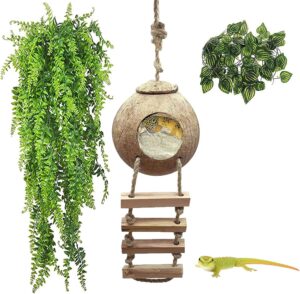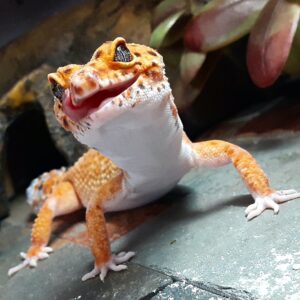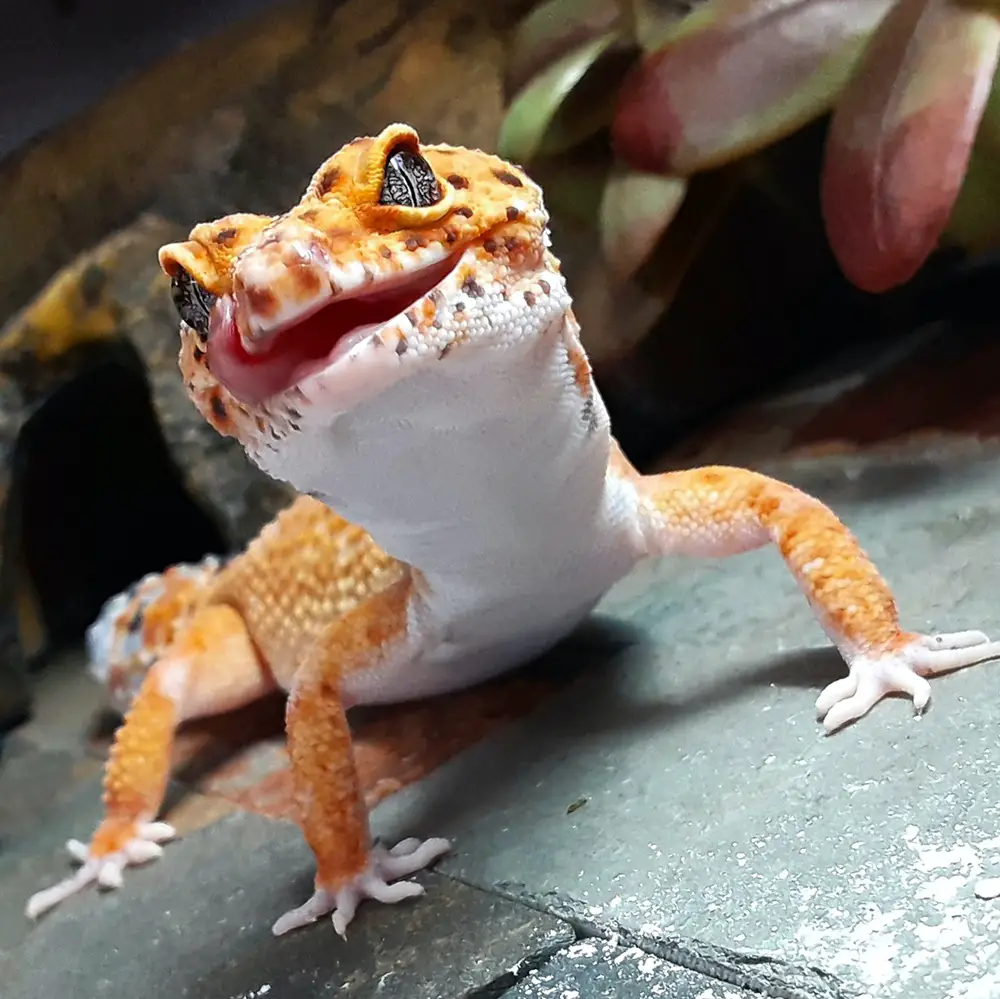Can leopard geckos climb glass
Can leopard geckos climb glass: Leopard geckos, with their vibrant patterns and docile nature, have become increasingly popular as reptile pets. Originating from the arid regions of Afghanistan, Pakistan, and India, these creatures belong to the Eublepharidae family. Their unique characteristics and low-maintenance requirements have made them a preferred choice for both experienced reptile enthusiasts and novice pet owners.
Brief Overview of Leopard Geckos as Popular Reptile Pets
 Leopard geckos (Eublepharis macularius) are medium-sized lizards known for their striking appearance and engaging behavior. They typically grow to about 8-10 inches in length and boast a remarkable variety of skin patterns, including spots, stripes, and blotches in shades of yellow, orange, brown, or white. Besides their aesthetic appeal, leopard geckos possess distinct traits that make them highly sought after pets.
Leopard geckos (Eublepharis macularius) are medium-sized lizards known for their striking appearance and engaging behavior. They typically grow to about 8-10 inches in length and boast a remarkable variety of skin patterns, including spots, stripes, and blotches in shades of yellow, orange, brown, or white. Besides their aesthetic appeal, leopard geckos possess distinct traits that make them highly sought after pets.
One notable characteristic is their gentle demeanor. Unlike many other reptiles that may exhibit aggression or skittish behavior when handled, leopard geckos are generally calm and tolerant of human interaction.
This temperament makes them ideal companions for individuals seeking a reptilian pet that can be easily handled without fear of aggression or injury. Another reason for their popularity is their relative ease to care for compared to other reptiles.
Leopard geckos thrive in terrariums where key environmental factors such as temperature, humidity levels, lighting conditions, and substrate type can be closely regulated. Additionally, they have specific dietary requirements consisting mainly of live insects like crickets or mealworms supplemented with calcium powder.
Intriguing Question: Can Leopard Geckos Climb Glass?
The question regarding the climbing abilities of leopard geckos has intrigued many pet owners and reptile enthusiasts alike. While it may seem unlikely at first glance due to the smooth and seemingly insurmountable nature of glass surfaces, leopard geckos have been observed exhibiting impressive climbing skills on various substrates, including glass.
The ability of a creature to climb vertical surfaces relies on several factors, such as anatomical adaptations and the principles of friction and adhesion. While many reptiles possess specialized toe pads with microscopic structures called setae that aid in climbing, it is essential to explore whether leopard geckos share similar adaptations or have alternative mechanisms that enable them to scale glass walls.
Understanding the science behind these remarkable feats can provide valuable insights into the unique abilities of leopard geckos and shed light on their evolutionary adaptations. In the following sections, we will delve deeper into the locomotion and climbing abilities of leopard geckos while exploring the fascinating world of glass climbing in these captivating reptiles.
Leopard Geckos: A Fascinating Species
Description of leopard geckos’ physical characteristics and natural habitat
 Leopard geckos (Eublepharis macularius) are a captivating species of reptile native to the arid regions of Afghanistan, Pakistan, and parts of India. These small to medium-sized lizards are instantly recognizable due to their striking appearance. They typically have a stout body with a length ranging from 6 to 10 inches, although some individuals can grow even larger.
Leopard geckos (Eublepharis macularius) are a captivating species of reptile native to the arid regions of Afghanistan, Pakistan, and parts of India. These small to medium-sized lizards are instantly recognizable due to their striking appearance. They typically have a stout body with a length ranging from 6 to 10 inches, although some individuals can grow even larger.
One of their most distinctive features is their segmented tail, which can be regenerated if lost or injured. Leopard geckos exhibit remarkable coloration and patterns that contribute to their allure as pets.
They come in various morphs, showcasing an array of vibrant shades such as yellow, orange, white, and brown. Additionally, they possess unique spots or blotches on their bodies that resemble those found on actual leopards – hence their name.
This intriguing combination of colors and patterns adds to their aesthetic appeal. In their natural habitat, leopard geckos inhabit arid regions characterized by rocky terrain and sparse vegetation.
They are primarily terrestrial creatures but are also skilled climbers when the need arises. The arid environment offers them sufficient warmth for basking while also providing adequate hiding places among rocks and crevices during the day when they prefer to remain hidden from predators.
Unique traits that make them popular pets, such as their docile nature and striking patterns
Leopard geckos have gained immense popularity among reptile enthusiasts due to several unique traits that make them excellent pets. One particular characteristic is their docile nature.
Unlike many other reptiles, leopard geckos are generally non-aggressive towards humans if properly handled and cared for from an early age. This gentle disposition makes them ideal companions for both experienced reptile keepers and beginners alike.
Furthermore, leopard geckos have captivating patterns that vary from individual to individual, making each one unique. This distinctive appearance appeals to pet owners who appreciate the aesthetic beauty of these creatures.
Additionally, their calm demeanor and relatively low maintenance requirements make them a preferred choice for those looking for reptile pets that are easy to manage. Leopard geckos are also known for their intriguing behaviors.
They are crepuscular creatures, meaning they are most active during dawn and dusk. Observing their hunting techniques or witnessing their tail-waving behavior as a form of communication can be truly fascinating.
These qualities, combined with their striking appearance and amiable temperament, have propelled leopard geckos to become one of the most sought-after reptile pets in the world today. Leopard geckos captivate reptile enthusiasts with their distinct physical characteristics and appealing attributes as pets.
Their robust body structure, segmented tail, vibrant colors, and leopard-like spots contribute to their visual allure. In addition to their striking appearance, leopard geckos’ docile nature and intriguing behaviors make them popular companions among reptile lovers of all levels of expertise.
Climbing Abilities of Leopard Geckos
Scaling the Heights: Leopard Gecko Locomotion
Leopard geckos may not possess the same gripping capabilities as their arboreal counterparts, but they are surprisingly adept at climbing various surfaces, including glass. Their locomotive prowess primarily relies on a combination of muscular coordination and specialized adaptations. Unlike tree-dwelling reptiles that rely on modified digits for climbing, leopard geckos employ an intriguing technique known as “chordate walking.” This method involves moving their limbs in a coordinated wave-like motion, enabling them to traverse horizontal and vertical surfaces with relative ease.
Anatomy Unveiled: Feet and Toes Designed for Climbing
The intricate anatomy of the leopard gecko’s feet and toes plays an essential role in facilitating their climbing abilities. Each foot possesses five clawed toes, each equipped with finely serrated scales that offer exceptional grip. These scales, known as lamellae, increase friction between the gecko’s toes and the surface they are navigating.
Moreover, these lamellar structures allow for greater surface area contact with the substrate or glass. At closer inspection, one can observe tiny hair-like structures called setae covering the undersides of a leopard gecko’s toes.
These intricate setae contain even smaller extensions known as spatulae—microscopic hook-like structures responsible for enhancing adhesion during climbing. The spatulae exploit weak intermolecular forces called van der Waals forces to create temporary molecular bonds between the gecko’s foot and the surface it is scaling.
Unlocking Glass Climbing Mysteries
When it comes to glass climbing specifically, leopard geckos employ similar techniques used for other surfaces but face additional challenges due to its smooth nature. The absence of rough textures reduces friction between their setae and glass surfaces compared to more textured substrates.
However, the geckos compensate for this by applying additional pressure with each step, maximizing contact and utilizing their clawed toes to help anchor onto the glass. This combination of surface area contact and increased grip force allows leopard geckos to surmount glass barriers that may appear insurmountable to humans.
Understanding the inherent capabilities of leopard geckos not only sheds light on their fascinating locomotion but also emphasizes their adaptability to climb an array of surfaces, including glass. By utilizing a combination of wave-like movements, specialized foot anatomy with lamellae and setae, and employing additional grip force when faced with smoother surfaces like glass, these remarkable reptiles can overcome the challenges presented by vertical obstacles.
The Science Behind Glass Climbing
Principles of Friction and Adhesion
 When it comes to understanding how animals are capable of climbing vertical surfaces like glass, the principles of friction and adhesion play a fundamental role. Friction is the force that opposes motion between two surfaces in contact, while adhesion refers to the attraction between molecules of different substances.
When it comes to understanding how animals are capable of climbing vertical surfaces like glass, the principles of friction and adhesion play a fundamental role. Friction is the force that opposes motion between two surfaces in contact, while adhesion refers to the attraction between molecules of different substances.
In order for an animal to climb, it must overcome the forces of gravity by utilizing these principles. Friction comes into play when the microscopic irregularities on both the climbing surface and the contacting body parts of an animal create interlocking points.
This interlocking generates a grip that counteracts gravity and allows the animal to maintain its position on a vertical surface. The rougher the surface, the more friction is produced, enhancing the animal’s ability to climb.
Adhesion, on the other hand, is related to intermolecular forces. When molecules from different substances come into close proximity, such as an animal’s climbing appendage and a smooth glass surface, van der Waals forces come into play.
Van der Waals forces are weak attractive forces between atoms or molecules due to temporary fluctuations in electron distribution. These forces allow certain animals to adhere to vertical surfaces by exploiting molecular attractions.
Van der Waals Forces: Crucial Role in Glass Climbing
Van der Waals forces are particularly significant in allowing animals like leopard geckos to climb glass surfaces with seemingly effortless ease. These attractive molecular interactions occur at extremely close distances and are responsible for creating adhesive forces far greater than one would expect based solely on gravity alone. The key players enabling van der Waals interactions during glass climbing are specialized structures found at a microscopic level within an animal’s toe pads or other gripping appendages.
In leopard geckos’ case, their toe pads possess uniquely adapted setae – tiny hair-like structures that greatly increase the surface area in contact with the surface. This increased contact area multiplies the number of van der Waals forces at work, enabling a stronger grip on the smooth glass surface.
By capitalizing on these intermolecular attractions, leopard geckos can effectively utilize van der Waals forces to create an adhesive bond between their toe pads and glass. This bond enables them to climb vertical surfaces with relative ease, defying gravity and showcasing their remarkable climbing abilities.
The science behind glass climbing in animals like leopard geckos involves a combination of friction and adhesion. Friction allows for interlocking between the irregularities on both surfaces, while adhesion is facilitated by van der Waals forces – weak attractive forces between molecules.
Through specialized adaptations like setae on their toe pads, leopard geckos can harness these forces to create an adhesive bond that allows them to climb glass surfaces effortlessly. Understanding these principles provides insight into the remarkable natural abilities of these reptiles and helps us appreciate their fascinating evolutionary adaptations.

Leopard Gecko Adaptations for Glass Climbing
Enhanced Climbing Abilities through Specialized Toe Pads
Leopard geckos, like some other reptiles, possess remarkable adaptations that enable them to climb glass surfaces with relative ease. One of the key features contributing to their climbing prowess is the presence of specialized toe pads.
These toe pads are covered in microscopic structures called setae, which play a crucial role in enhancing their grip on smooth surfaces like glass. These tiny structures provide an increased surface area for contact with the substrate, increasing friction and adhesion.
The Intricate Microscopic Structures: Setae
Setae are fascinating structures found on the toe pads of leopard geckos, allowing them to navigate vertical terrains effortlessly. Under close examination, these setae reveal a complex arrangement of minuscule bristles or hairs that interlock with irregularities on the surface they climb.
The highly efficient adhesion provided by these setae arises from specialized mechanisms known as van der Waals forces. These forces involve weak electrical attractions between molecules, allowing geckos to cling to glass by utilizing molecular interactions at a microscopic level.
Comparative Insights: Other Reptiles with Similar Adaptations
While leopard geckos possess exceptional adaptations for glass climbing, they are not alone in this ability within the reptile kingdom. Other reptiles such as anoles and tokay geckos also display similar adaptations, emphasizing the importance of toe pad specializations in enabling them to traverse vertical surfaces effectively. Anoles have lamellae on their toe pads that function similarly to setae in leopard geckos.
Additionally, tokay geckos have unique adhesive scales on their toes that provide enhanced grip and allow them to scale smooth objects effortlessly. These examples demonstrate that multiple reptile species have convergently evolved specialized adaptations to conquer the challenges of climbing smooth surfaces.
The remarkable adaptations found in leopard geckos, including their specialized toe pads and intricate setae, provide them with a distinct advantage in navigating glass terrains. Understanding the intricacies of these adaptations not only enhances our appreciation for these captivating creatures but also sheds light on the fascinating mechanisms that drive their remarkable climbing abilities.
Factors Influencing Glass Climbing Ability in Leopard Geckos
Environmental factors affecting a leopard gecko’s ability to climb glass surfaces
 Leopard geckos’ climbing abilities can be influenced by several environmental factors. One of the crucial factors is the temperature and humidity levels in their enclosure.
Leopard geckos’ climbing abilities can be influenced by several environmental factors. One of the crucial factors is the temperature and humidity levels in their enclosure.
Leopard geckos are ectothermic creatures, meaning they rely on external heat sources to regulate their body temperature. Optimal temperature conditions are essential for their muscle function and grip strength when climbing smooth surfaces like glass.
Inadequate temperatures can result in reduced muscle efficiency and make it harder for them to maintain a strong grip on vertical surfaces. Another environmental factor that affects the glass-climbing ability of leopard geckos is humidity.
Lower humidity levels can lead to dry skin, which may cause their toe pads to lose some adhesion, making it more challenging for them to climb smooth surfaces effectively. It is crucial to ensure a suitable humidity range within the gecko’s enclosure to maintain healthy skin conditions and optimize their grip on glass or other climbing surfaces.
Temperature and humidity levels impacting grip strength
Temperature plays a vital role in influencing the grip strength of leopard geckos when climbing glass. Too high or too low ambient temperatures can affect muscle performance and limit the gecko’s ability to exert enough force through its feet onto the surface it is trying to climb. A moderate temperature range of approximately 80-90°F (27-32°C) allows for optimal muscle function, enhancing their gripping capabilities.
Similarly, humidity levels significantly impact grip strength when climbing smooth surfaces like glass. If the air inside the enclosure is excessively dry or lacks sufficient moisture, it can negatively affect the condition of a leopard gecko’s skin and toe pads.
Dry skin reduces adhesion due to decreased friction against glass, making it more difficult for them to sustain traction while climbing. Maintaining a suitable humidity level, generally between 30-40%, ensures proper skin health and maximizes the gecko’s ability to grip glass surfaces effectively.
Substrate type and texture affecting traction
Apart from temperature and humidity, the type and texture of the substrate within a leopard gecko’s enclosure can also impact their climbing abilities on glass. Some common types of substrates used in leopard gecko enclosures include reptile carpet, paper towels, slate tiles, or textured mats. These substrates provide a more secure footing compared to smooth glass surfaces.
The texture of the substrate also affects traction for leopard geckos. A rougher surface allows for better grip due to increased friction between their feet and the substrate material.
This enhanced traction can significantly aid their climbing ability on both horizontal and vertical surfaces. However, if the enclosure is entirely lined with smooth glass or has only a thin layer of loose substrate on top, it may present challenges to leopard geckos trying to climb vertically.
In such cases, they may struggle to find sufficient toe pad contact with the slippery surface or fail to get enough traction for a successful climb. Overall, by considering these environmental factors such as temperature, humidity levels, and substrate type/texture within their habitat design, we can ensure that our leopard geckos have optimal conditions for showcasing their natural climbing abilities even on challenging glass surfaces.
Challenges Faced by Leopard Geckos when Climbing Glass
Potential risks associated with glass climbing for these reptiles
Climbing glass can present a number of challenges and potential risks for leopard geckos. Firstly, the smooth surface of glass provides less natural grip compared to rougher substrates found in their natural habitat.
This lack of traction increases the risk of slipping and falling, which can lead to injuries such as broken bones or tail fractures. Additionally, leopard geckos may struggle to find secure footing on glass surfaces due to their specialized toe pads being less effective on smooth materials.
Another challenge leopard geckos face when climbing glass is the potential for stress and anxiety. These reptiles are primarily terrestrial creatures and are not naturally equipped to navigate vertical surfaces like glass.
Their inability to adapt to this unfamiliar environment may cause them distress, as they may feel insecure or unable to maintain control over their movements. Prolonged exposure to stressful situations can negatively impact their overall well-being, leading to health issues such as decreased appetite or weakened immune systems.
Environmental factors exacerbating risks
Several environmental factors can worsen the challenges faced by leopard geckos when climbing glass surfaces. Temperature and humidity levels play a crucial role in determining a gecko’s ability to maintain grip strength. If the enclosure is too hot or humid, it can cause excessive sweating on their feet, making them more prone to slipping or losing traction on smooth surfaces like glass.
The type and texture of substrate within the enclosure also influence a gecko’s ability to climb glass effectively. If an inappropriate substrate is utilized, such as loose sand or pebbles that do not provide enough stability underfoot, it further compromises their ability to establish secure footing on vertical surfaces.
To sum up can leopard geckos climb glass
While leopard geckos possess some natural climbing abilities, glass surfaces present a unique set of challenges for these reptiles. The potential risks associated with glass climbing include injuries from falling, increased stress levels, and difficulties finding reliable footing due to the smooth texture of glass.
Environmental factors such as temperature, humidity, and substrate quality can further exacerbate these challenges. However, it is important to note that with proper care and attention to their habitat conditions, leopard geckos can thrive as pets without needing to climb glass.
Providing them with suitable substrates, carefully monitoring temperature and humidity levels within their enclosure, and prioritizing their overall well-being will greatly mitigate the risks associated with glass climbing. By ensuring a secure and enriched environment for these captivating creatures, we can appreciate and enjoy their unique characteristics while also safeguarding their health and happiness.


